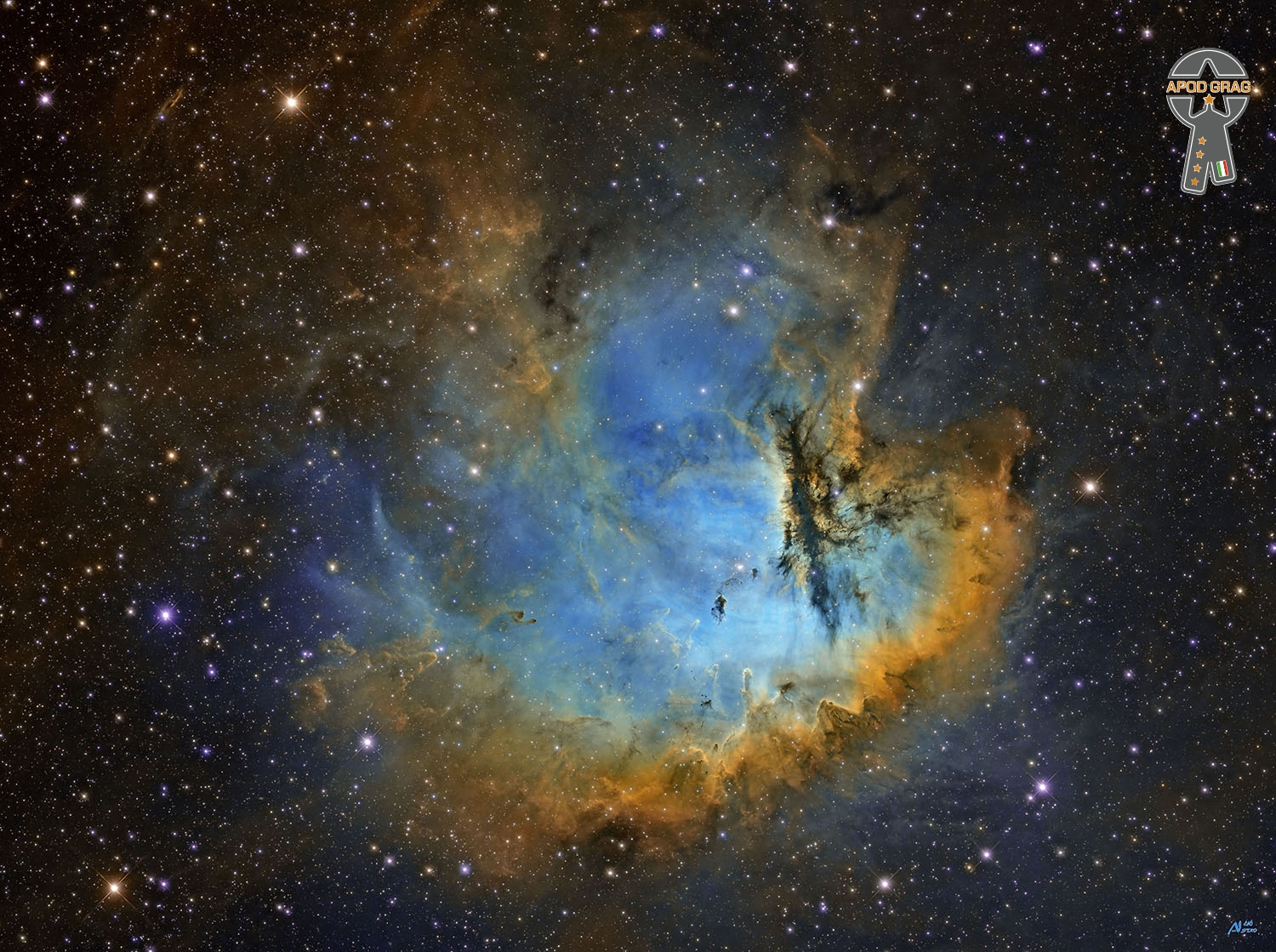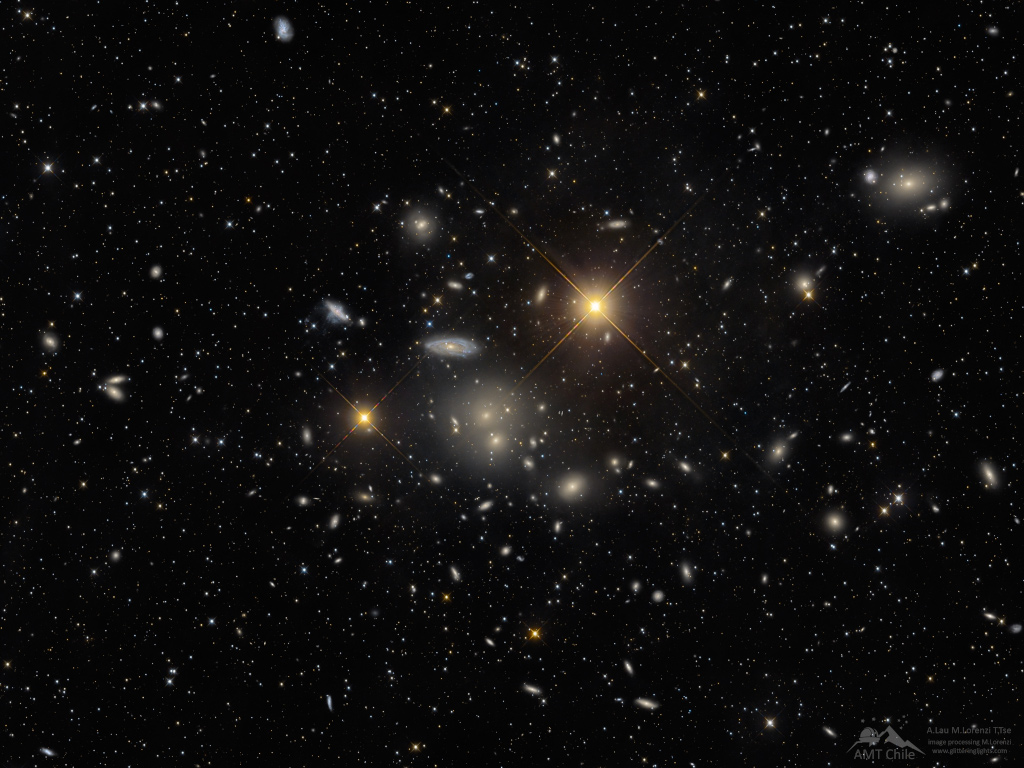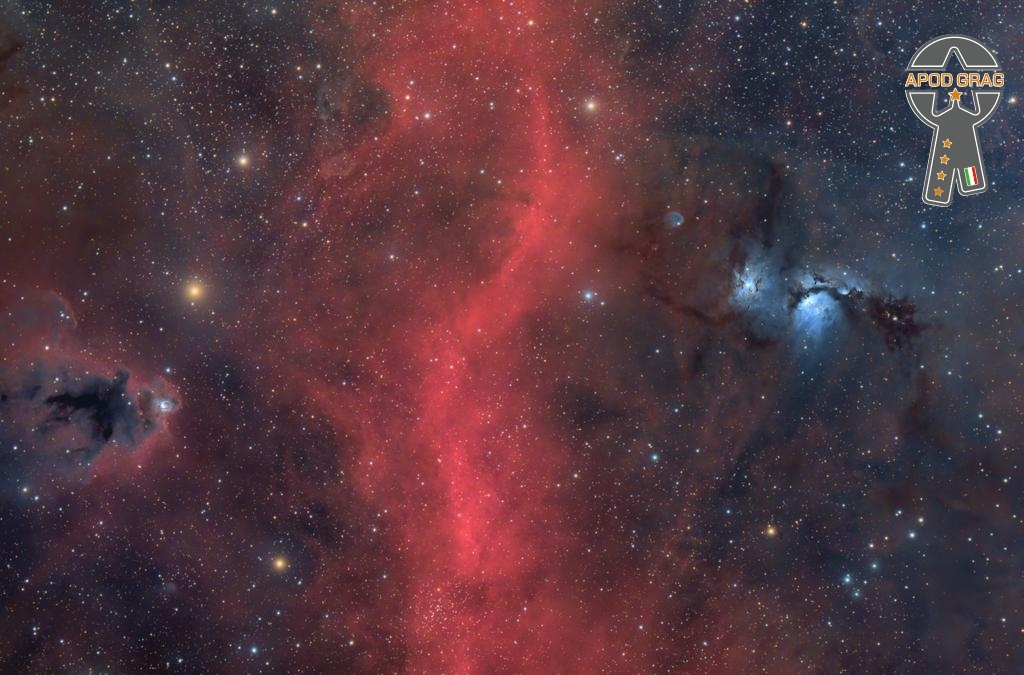NGC 281 is a HII region located about 10 000 light-years from Earth in the constellation Cassiopeia. With a diameter of about 100 light-years, it is part of the Perseus Arm. It includes or is close to the open cluster IC 1590, the double star HD 5005 and several Bok globules. It is visible through an amateur telescope in areas where the night sky is sufficiently dark. It is sometimes unofficially called the Pacman Nebula because of its coincidental resemblance to the eponymous hero of the arcade game Pac-Man.
This emission nebula was discovered by the American astronomer Edward Barnard in 1881.
Photo taken in Normandy France from 05/08 to 17/12/22.

Jeremy Webster “Fred” Frith (born 17 February 1949) is an English multi-instrumentalist, composer, and improviser.
Probably best known for his guitar work, Frith first came to attention as one of the founding members of the English avant-rock group Henry Cow. He was also a member of the groups Art Bears, Massacre, and Skeleton Crew. He has collaborated with a number of prominent musicians, including Robert Wyatt, Derek Bailey, the Residents, Lol Coxhill, John Zorn, Brian Eno, Mike Patton, Lars Hollmer, Bill Laswell, Iva Bittová, Jad Fair, Kramer, the ARTE Quartett, and Bob Ostertag. He has also composed several long works, including Traffic Continues (1996, performed 1998 by Frith and Ensemble Modern) and Freedom in Fragments (1993, performed 1999 by Rova Saxophone Quartet). Frith produces most of his own music, and has also produced many albums by other musicians, including Curlew, the Muffins, Etron Fou Leloublan, and Orthotonics.
He is the subject of Nicolas Humbert and Werner Penzel’s 1990 documentary Step Across the Border. Frith also appears in the Canadian documentary Act of God, which is about the metaphysical effects of being struck by lightning. He has contributed to a number of music publications, including New Musical Expressand Trouser Press, and has conducted improvising workshops across the world. His career spans over four decades and he appears on over 400 albums, and he still performs actively throughout the world.
Frith was awarded the 2008 Demetrio Stratos Prize for his career achievements in experimental music. The prize was established in 2005 in honour of experimental vocalist Demetrio Stratos, of the Italian group Area, who died in 1979. In 2010 Frith received an honorary doctorate from the University of Huddersfield in West Yorkshire, England, in recognition of his contribution to music. Frith was Professor of Composition in the Music Department at Mills College in Oakland, California, until his retirement in 2018. He is the brother of Simon Frith, a music critic and sociologist, and Chris Frith, a psychologist at University College London.
see full post...(born. February 17, 1937, Chicago). He is best known as baritone, background vocals, with The Dells from -1952–2012. The Dells were an American R&B vocal group. Formed in high school in 1952 by founding members Marvin Junior, Verne Allison, Johnny Funches, Chuck Barksdale, and Mickey and Lucius McGill, under the name the El-Rays, they released their first recording in 1954, and two years later, had their first R&B hit with “Oh What a Night”. After disbanding due to a near-fatal car crash in 1958, the band reformed in 1960 with Funches being replaced by Johnny Carter. This lineup remained together until Carter’s 2009 death. The Dells were inducted to the Rock and Roll Hall of Fame and the Vocal Group Hall of Fame in 2004. The vocal group performed until illness forced longtime lead singer Marvin Junior and bass vocalist Chuck Barksdale into retirement, ending the group’s 60-year run.
The Dells grew up in Harvey, Illinois and began singing together while attending Thornton Township High School. Forming in 1952 under the name the El-Rays, the group initially consisted of Marvin Junior, Mickey McGill, Lucius McGill, Verne Allison, Chuck Barksdale, and Johnny Funches. Lucius soon left the group and the remaining quintet signed with Checker Records, releasing their first single, “Darling I Know,” which flopped.
see full post...There are two parts to a Fandangos de Huelva, including the estribillo, a rhythmic chordal refrain played on the guitar with or without singing, and the coplas. These two parts alternate, similar to the chorus and verse in a folk song: The compás for the Fandangos de Huelva is a six count pattern with accents on the third and fifth beats.
Each copla (verse) of the Fandangos de Huelva contains six sets of twelve counts, and dancers usually perform several verses of the song, or trade off performing a verse with another dancer. In a performance, the guitarist plays two or four sets of estribillos before each copla. The singer may also sing the estribillo before the first copla. When performed in the traditional, regional style, steps are characterized by beautiful leg gestures, flicks of the feet, jota steps and jumps, escuela bolera steps and patterns, a small amount of taconeo/zapateado, castanets, and a distinctive arched line in the back of the dancer – torcido – which produces a spiraling effect. The dance is also often performed aflamencada, in a flamenco style that includes footwork, flamenco marking steps and cues, and llamadas and remates that are similar to those found in Bulerías.
The typical scenario for a traditional Fandangos de Huelva dance (performed by soloists or in groups) is as follows:
-
Entrance/entrada
-
Danced to a musical (with or without cante) estribillo
-
-
1st copla
-
Each verse contains six sets of twelve count phrases, performed with or without castanets, and includes traditional regional or flamenco steps and phrases
-
-
Estribillo transition
-
Two to four sets of twelve count phrases are performed to the estribillo music, acting as transitions between the coplas (verses). These transitions allow dancers to enter or exit the stage.
-
-
Arrimaté
-
A traditional cierre (closing/ending) for cante and baile por Fandangos de Huelva
-
Three large galaxies, ellipticals and a spiral blue,
Dominant and grand, each 150,000 light-years wide,
But it was the overlapping pair that caught my view,
Cataloged as NGC 3314, a sight I cannot hide.
Abell 1060, the Hydra galaxy cluster’s name,
One of three large galaxy clusters close to our Milky Way,
A universe bound by gravity, a celestial game,
Where clusters align over larger scales, I cannot sway.
At a distance of 100 million light-years, this snapshot’s size,
1.3 million light-years across, a cosmic delight,
A momentary glimpse into the universe’s guise,
But even this shall fade, and be nevermore in sight.

Otis Blackwell (February 16, 1931 – May 6, 2002) was an American songwriter whose work influenced rock and roll. His compositions include “Fever” (recorded by Little Willie John), “Great Balls of Fire” and “Breathless” (recorded by Jerry Lee Lewis), “Don’t Be Cruel“, “All Shook Up” and “Return to Sender” (with Winfield Scott; recorded by Elvis Presley), and “Handy Man” (recorded by Jimmy Jones).
Blackwell was born in Brooklyn, New York. He learned to play the piano as a child and grew up listening to both R&B and country music. His first success was winning a local talent contest (“Amateur Night”) at the Apollo Theater in Harlem in 1952. This led to a recording contract with RCA and then with Jay-Dee. His first release was his own composition “Daddy Rolling Stone“, which became a favorite in Jamaica, where it was recorded by Derek Martin. The song later became part of the Who‘s mod repertoire.
see full post...Carlos Paredes ComSE (Portuguese pronunciation: 16 February 1925 – 23 July 2004) was a virtuoso Portuguese guitar player and composer. He is regarded as one of the greatest players of Portuguese guitar of all-time.
Born in Coimbra, Portugal, in a family with a long tradition of guitar playing, he was taught to play the Portuguese guitar by his father, Artur Paredes. He composed numerous soundtracks for cinema and theatre, such as the soundtrack for the Portuguese film Os Verdes Anos (1963), which contains his famous piece “Canção Verde Anos”. He released several recordings as a solo artist and performed in numerous countries worldwide.
see full post...William Ballard Doggett (February 16, 1916 – November 13, 1996) was an American pianist and organist. He began his career playing swing music before transitioning into rhythm and blues. Best known for his instrumental compositions “Honky Tonk” and “Hippy Dippy”, Doggett was a pioneer of rock and roll. He worked with the Ink Spots, Johnny Otis, Wynonie Harris, Ella Fitzgerald, and Louis Jordan.
Doggett was born in Philadelphia. During the 1930s and early 1940s he worked for Lucky Millinder, Frank Fairfax and arranger Jimmy Mundy. In 1942 he was hired as the Ink Spots‘ pianist and arranger.
In 1951, Doggett organized his own trio and began recording for King Records. His best known recording is “Honky Tonk“, a rhythm and blues hit of 1956, which sold four million copies (reaching No. 1 R&B and No. 2 Pop), and which he co-wrote with Billy Butler.
see full post...Giuseppe “Joe” Venuti (September 16, 1903 – August 14, 1978) was an American jazz musician and pioneer jazz violinist.
Considered the father of jazz violin, he pioneered the use of string instruments in jazz along with the guitarist Eddie Lang, a friend since childhood. Through the 1920s and early 1930s, Venuti and Lang made many recordings as leader and as featured soloists. He and Lang became so well known for their ‘hot’ violin and guitar solos that on many commercial dance recordings they were hired to do 12- or 24-bar duos towards the end of otherwise stock dance arrangements. In 1926, Venuti and Lang started recording for the OKeh label as a duet (after a solitary duet issued on Columbia), followed by “Blue Four” combinations, which are considered milestone jazz recordings. Venuti also recorded commercial dance records for OKeh under the name “New Yorkers”.
He worked with Benny Goodman, Adrian Rollini, the Dorsey Brothers, Bing Crosby, Bix Beiderbecke, Jack Teagarden, Frank Signorelli, the Boswell Sisters, and most of the other important white jazz and semi-jazz figures of the late 1920s and early 1930s. However, following Lang’s death in 1933, Venuti’s career began to wane, though he continued performing through the 1930s, recording a series of commercial dance records (usually containing a Venuti violin solo) for the dime store labels, as well as OKeh and Columbia, plus the occasional jazz small group sessions. He was also a strong early influence on western swing players like Cecil Brower. Many of the 1920s OKeh sides continued to sell and remained in print through 1935 when ARCdiscontinued the OKeh label and reissued selected sides on the 35-cent Vocalion label (the OKeh label was revived by CBS in 1940).
see full post...Messier 78 or M78, also known as NGC 2068, is a reflection nebula in the constellation Orion. It was discovered by Pierre Méchain in 1780 and included by Charles Messier in his catalog of comet-like objects that same year.
M78 is the brightest diffuse reflection nebula of a group of nebulae that includes NGC 2064, NGC 2067 and NGC 2071. This group belongs to the Orion B molecular cloud complex and is about 1,350 light-years distant from Earth. M78 is easily found in small telescopes as a hazy patch and involves two stars of 10th and 11th magnitude. These two B-type stars, HD 38563 A and HD 38563 B, are responsible for making the cloud of dust in M78 visible by reflecting their light.

Alistair Ian Campbell (born 15 February 1959) is an English singer and songwriter who was lead singer of the British reggae band UB40. As part of UB40, Campbell sold over 70 million records worldwide and toured the globe for 30 years. In 2008, Campbell left UB40 due to a dispute with band management and embarked on a solo career. In 2012, Campbell was announced as one of the three judges on the panel of the TV show New Zealand’s Got Talent. In August 2014, Campbell announced he had reunited with former UB40 bandmates Astro and Mickey to record a new album, Silhouette, released on 6 October 2014.
Alistair Ian Campbell was born in Birmingham, England. He is the brother of former bandmate Robin Campbell and former UB40 frontman Duncan Campbell, and is a son of the late Scottish folk singer Ian Campbell.
see full post...Melissa Manchester (born February 15, 1951) is an American singer, songwriter and actress. Since the 1970s, her songs have been carried by adult contemporary radio stations. She has also appeared on television, in films, and on stage.
Manchester was born in the Bronx, a borough of New York City, into a musical family. Her father, David Manchester, was a bassoonist for the New York Metropolitan Opera for three decades. Her mother was one of the first women to design and found her own clothing firm, Ruth Manchester Ltd. The Manchesters are of Jewish origin.
Manchester started a singing career at an early age. She learned the piano and harpsichord at the Manhattan School of Music, began singing commercial jingles at age 15, and became a staff writer at age 17 for Chappell Music while attending Manhattan’s High School of Performing Arts.
She studied songwriting at New York University with Paul Simon when she was 19. Manchester played the Manhattan club scene, where Barry Manilow, a friend and fellow jingles singer introduced her to Bette Midler. In 1971, she became a member of the Harlettes, the back-up singers for Midler, which she co-created with Manilow.
see full post...Henry Threadgill (born February 15, 1944) is an American composer, saxophonist and flautist. He came to prominence in the 1970s leading ensembles rooted in jazz but with unusual instrumentation and often incorporating other genres of music. He has performed and recorded with several ensembles: Air, Aggregation Orb, Make a Move, the seven-piece Henry Threadgill Sextett, the twenty-piece Society Situation Dance Band, Very Very Circus, X-75, and Zooid.
He was awarded the 2016 Pulitzer Prize for Music for his album In for a Penny, In for a Pound, which premiered at Roulette Intermedium on December 4, 2014
Threadgill performed as a percussionist in his high-school marching band before taking up baritone saxophone, alto saxophone, and flute. He studied at the American Conservatory of Music in Chicago, majoring in piano, flute, and composition. He studied piano with Gail Quillman and composition with Stella Roberts.[3] He was an original member of the Experimental Band,a precursor to the AACM in his hometown of Chicago, and worked under the guidance of Muhal Richard Abrams, before leaving to tour with a gospelband. In 1967, he enlisted in the U.S. Army, playing with a rock band in Vietnam during the Vietnam War in 1967 and 1968. He was discharged in 1969.
see full post...Harold Arlen (born Hyman Arluck; February 15, 1905 – April 23, 1986) was an American composer of popular music, who composed over 500 songs, a number of which have become known worldwide. In addition to composing the songs for the 1939 film The Wizard of Oz (lyrics by Yip Harburg), including “Over the Rainbow“, Arlen is a highly regarded contributor to the Great American Songbook. “Over the Rainbow” was voted the 20th century’s No. 1 song by the RIAA and the NEA.
Arlen was born in Buffalo, New York, the child of a Jewish cantor. His twin brother died the next day. He learned to play the piano as a youth, and formed a band as a young man. He achieved some local success as a pianist and singer before moving to New York City in his early twenties, where he worked as an accompanist in vaudeville and changed his name to Harold Arlen. Between 1926 and about 1934, Arlen appeared occasionally as a band vocalist on records by The Buffalodians, Red Nichols, Joe Venuti, Leo Reisman, and Eddie Duchin, usually singing his own compositions.
In 1929, Arlen composed his first well-known song: “Get Happy” (with lyrics by Ted Koehler). Throughout the early and mid-1930s, Arlen and Koehler wrote shows for the Cotton Club, a popular Harlem night club, as well as for Broadway musicals and Hollywood films. Arlen and Koehler’s partnership resulted in a number of hit songs, including the familiar standards “Let’s Fall in Love” and “Stormy Weather“. Arlen continued to perform as a pianist and vocalist with some success, most notably on records with Leo Reisman‘s society dance orchestra.
see full post...James “Kokomo” Arnold (February 15, 1896 or 1901 – November 8, 1968) was an American bluesmusician. A left-handed slide guitarist, his intense style of playing and rapid-fire vocal delivery set him apart from his contemporaries. He got his nickname in 1934 after releasing “Old Original Kokomo Blues” for Decca Records, a cover version of Scrapper Blackwell‘s blues song about the city of Kokomo, Indiana.
Arnold was born in Lovejoy’s Station, Georgia. Most sources give the date his birth as 1901, but the researchers Bob Eagle and Eric LeBlanc give the date as 1896, on the basis of information in the 1900 census. He learned the basics of playing the guitar from his cousin, John Wiggs.
see full post...